The Line
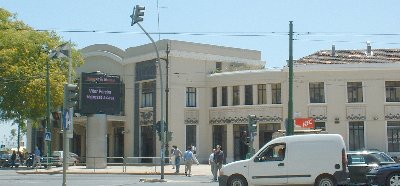
Cais do Sodré station.
The Cascais Line, often known in Britain as the 'Estoril Line', provides an attractive excursion from Lisbon for a number of reasons:
It provides excellent views which include the River Tagus, the Atlantic Ocean, and the historical sights of Belém
It is a paragon of efficient operation and tight timetabling of frequent semi-fast and stopping trains which run for virtually 24 hours a day
It is cheap
It provides a quick escape from city life to the beaches of Estoril or Cascais
It is convenient; the starting point is at Cais do Sodré, which is on the Metro system (Green Line) and is only five minutes' walk from the Praça do Comércio or an even shorter tram ride from there (on route #15 or 18).
The line connects Lisbon (Cais do Sodré station) and the coastal resorts of Estoril and Cascais. Cascais, where the route terminates,is 26km from Cais do Sodré. The line opened, from Cascais to Pedrouços on
30 September 1889. (Pedrouços station, adjacent to the Torre de Belém, was taken out of commission about 100 years later but remains of its platforms could still be seen afterwards, between Belém and Algés). Services reached Alcântara-Mar on 6 December 1890 and finally arrived at Cais do Sodré on 4 September, 1895.
By 1924 the line had been leased to the Sociedade Estoril, which remained outside the CP (Portuguese Railways) network until aftre the Portuguese Revoultion, being nationalised in 1976. The service was electrified at 1500 volts from 1926. In 1950 new stock was ordered from Cravens of Sheffield and GEC of Manchester. The Portuguese manufacturer produced more new stock in 1959, albeit with GEC equipment, to a stainless-steel Budd design. Subsequently the Cravens cars were repainted in silver and all the fleet has worn a bright yellow window band since 1991.
Further stock deliveries allowed the introduction of seven-car trains from 1971. These continue today; peak services normally operate with seven-car mixtures of Cravens and Sorefame types.
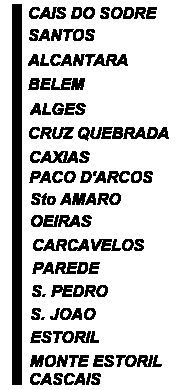
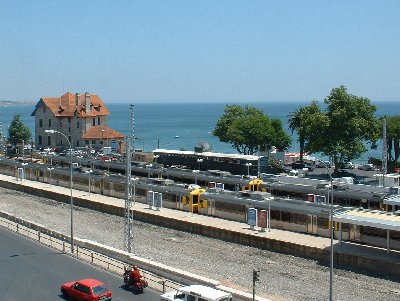
Cascais station, looking towards Lisbon, with the Atlantic Ocean beyond.
The Services
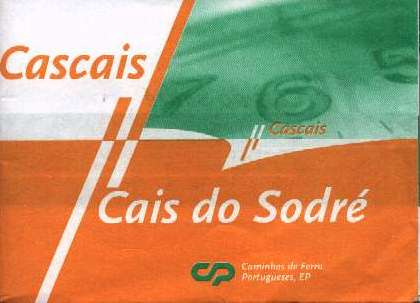
A Cascais Line timetable booklet.
Services run from c.0530 to c.0330 each day, although they terminate slightly earlier outside the summer period. They formerly comprised a tightly scheduled combination of through trains to/from Cascais, with up to twelve services an hour leaving Cais do Sodré. Trains operated a variety of services, with the standard pattern being semi-fast services to Cascais interspersed by short-runnings which stop at all stations to the intermediate stop at
Oeiras (17km from Cais do Sodré).
At peak times there were also a few services to São Pedro; at such times three services could leave Cais do Sodré within a five minute period. One of these services would only stop at Alcântara, Algés, Oeiras, Carcavelos,
Parede and would terminate at S. Pedro. The next train would duplicate these stops but go forward to S. Pedro and then all stations to Cascais. The third service would terminate at Oeiras but stop at all stations. Timings were such that passengers catching a stopping train need only cross the platforms at Oeiras or S. Pedro and wait two minutes before the Cascais service arrived.
Nowadays (2019) the timetable pattern is a little more simplified. During the morning rush hour, up to about 1000, alternate trains now run from Cais do Sodré via 'all stations to Cascais'. These alternate with short workings to Oeiras, which only stop at
Alcantara-Mar and Algés. THis same alternative pattern also operates in the evening rush hour period.
During the rest of the day (2019), all trains operate an all-stops service to Cascais. It is therefore not possible nowadays to reach Cascais in fewer than 40 minutes whereas the former system allowed the journey to be made with fewer stops in 32 minutes. Such is progress.
To avoid getting on the wrong train in peak periods look closely at the indicators. Services saying "Cascais TODAS" stop at every station but in peak periods Cascais trains do not stop at every station and the word TODAS (all stations) is therefore not displayed.
The Route
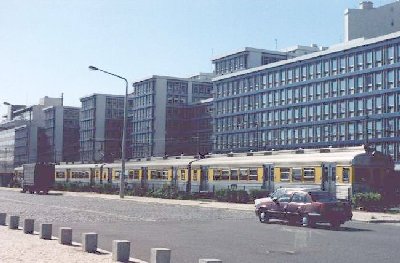
The route serves seventeen stations and for much of its length follows the Tagus estuary and Atlantic coast. On the pre-1998 stock, you could find fold-up seats at the front of the train, adjacent to the driver's cab, which afforded an excellent forward view of the route but these have now all gone. For river and sea-views, however, the left-hand side of the train is preferable. Sitting on the right affords good views of the Jerónimos monastery at Belém. A description of the route will be found below:
 CAIS DO SODRÉ (0km) The station, has a walkway link to the Estação Fluvial (River-Ferry Terminal, with services to Cacilhas) and lies about a ten-minute walk, or a short tram-ride (service 15) from the Praça do Comércio. A Metro station, on the Green Line, which originally had its own subterranean waterfall, was opened in 1998 at Cais do Sodré. The Metro link from here to Santa Apolónia railway station via a new station built at the Terreiro do Paço river-ferry terminal opened several years late due to tunnelling problems at the riverside.
CAIS DO SODRÉ (0km) The station, has a walkway link to the Estação Fluvial (River-Ferry Terminal, with services to Cacilhas) and lies about a ten-minute walk, or a short tram-ride (service 15) from the Praça do Comércio. A Metro station, on the Green Line, which originally had its own subterranean waterfall, was opened in 1998 at Cais do Sodré. The Metro link from here to Santa Apolónia railway station via a new station built at the Terreiro do Paço river-ferry terminal opened several years late due to tunnelling problems at the riverside.
Stairs and escalators were installed on the refurbished platforms at Cais do Sodré to allow direct access down to the Metro station below. By the end of station remodelling in 1999 there were six tracks for the Cascais line serving three platforms, with a seventh stabling track in place.
In 2007 major refurbishment of the original station building took place and there are now shops as well as connecting walkways to the adjacent ferry station. With trams and buses also stopping immediately outside, Cais do Sodré is an excellent inter-modal hub.
 SANTOS (0.9km) The former dockland area to the left of the line has now largely been reborn as a strip of discotheques and fashionable nightclubs, restaurants and bars.
SANTOS (0.9km) The former dockland area to the left of the line has now largely been reborn as a strip of discotheques and fashionable nightclubs, restaurants and bars.
On leaving Cais do Sodré, to the right, is a pleasant small garden; the train passes the Aterro district then, across the road to the right, between Santos and the next station, Alcântara, at the top of a lengthy flight of stairs, is the Museu de Arte Antiga, (Lisbon's Museum of Ancient Art). The staircase affords a fine view of the dock area and the river beyond.
Tram service 15 runs parallel and adjacent to the railway on reserved track along this stretch.
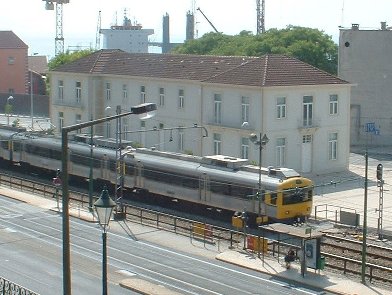
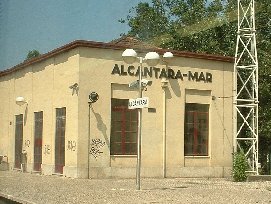

L to R: A Cascais-bound train approaches Alcântara; the eastbound platform of Alcântara-Mar station; a diesel loco uses the street-side track heading from Alcântara-Mar to Alcântara-Terra in 2010.
 ALCÂNTARA-MAR (2.6km) An elevated walk-way connects this station to the CP terminal station of Alcântara-Terra. To the left are part of the city's extensive passenger and cargo docks. Nearby, to the right, is the Necessidades Palace and the Carris tram sheds, museum and offices at Santo Amaro, (not to be confused with Santo Amaro [de Oeiras], a stop further along this railway line).
ALCÂNTARA-MAR (2.6km) An elevated walk-way connects this station to the CP terminal station of Alcântara-Terra. To the left are part of the city's extensive passenger and cargo docks. Nearby, to the right, is the Necessidades Palace and the Carris tram sheds, museum and offices at Santo Amaro, (not to be confused with Santo Amaro [de Oeiras], a stop further along this railway line).
Across the River Tagus, to the left, lie the now defunct Lisnave dry-dock and shipyards. There is, however, still a naval base here.
1km beyond Alcântara-Mar there was historically a halt called Junqueira. The line now passes directly under the massive Ponte 25 de Abril suspension bridge which has railtracks laid on its lower level, beneath the roadway.
This railway link opened in 1999, and provides direct double-decker train links from Lisbon to Setúbal without the need to cross by ferry to Barreiro station as was formerly the case.
On the right, inland on the Avenida da Índia, is the yellow, 394 metre-long and single-storey eighteenth-century Cordoaria Velha (the royal rope factory, created in 1771 and crucial in supplying the country's maritime fleets). This is now an exhibition area.
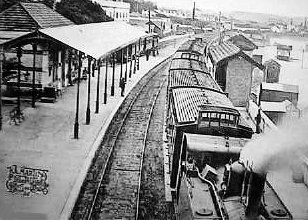
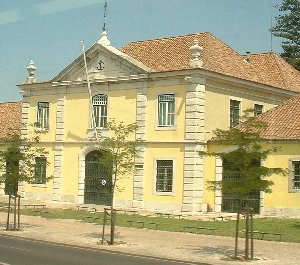
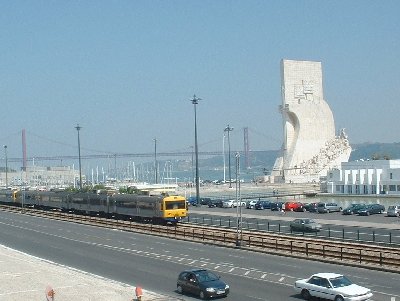
An early view of Algés station; the yellow frontage of the Cordoaria (rope works); the line runs past the monument to the Discoveries at Belém, where the track runs on reserved track with roadways on both sides.
 BELÉM (4.8km) Alight here for the Museu de Electricidade (Electricity Museum), housed in the former power station (1919) to the left, and the new MAAT museum.
BELÉM (4.8km) Alight here for the Museu de Electricidade (Electricity Museum), housed in the former power station (1919) to the left, and the new MAAT museum.
However, more importantly, the Museu dos Coches (Horse-Drawn Coaches Museum) is now housed immediately next to the station on the inland side in an impressive modern building. The hitorisal home of the museum remains as a satellite, just across the road, further inland.
Also visible from the train is the pink-plastered Palace of the President of Portugal, to the right, which was formerly a royal palace and which now houses a museum.
After the train leaves Belém station, short way forward from the station to the right, is the celebrated Jerónimos monastery, built in the early sixteenth century in the Manueline style. This used to be served by a halt called Bom Sucesso (7km), named after the adjacent dock of the same title. In front of the monastery is the Praça do Império, with its formal gardens and Fonte Monumental (fountain).
On the left by the river-edge is the striking Padrão dos Descobrimentos, a monument to the Portuguese Discoveries in the form of a stylised ship's prow, which pays homage to the Portuguese Voyages of Discovery of the late fifteenth-century and later, many of which actually set sail from Belém. An internal lift allows visitors to ascend to the top of the monument for fine views of the Belém area.
Adjacent to the Jerónimos is the Museu de Marinha (Maritime Museum), which has a large collection of model and real boats, as well as the Fairey sea-plane used for the first crossing from Portugal to Brazil. Behind the monastery are the floodlights of the Restelo Stadium, home of the Belenenses football club.
Nearer to the track, on the right, is the massive Centro Cultural de Belém, the location for arts and other cultural events. It has a pleasant rooftop café. Opposite it, on the left, is the Museu de Arte Popular. After Belém, just before the line curves right past the site of the former station of Pedrouços station (6.8km), there is a fine view, to the left of the Torre de Belém. which, before the 1755 earthquake stood in the river proper.
 ALGÉS (7.8km) There is a major bus interchange adjacent to the station, on the right, behind which runs the tram route 15. To the left on the approach to the station a school has recently been replaced by a new road and roudabout.
ALGÉS (7.8km) There is a major bus interchange adjacent to the station, on the right, behind which runs the tram route 15. To the left on the approach to the station a school has recently been replaced by a new road and roudabout.
Algés is a major middle-class commuting area for Lisbon workers. Leaving Algés, on the right may be seen the yellow Aquário Vasco da Gama, (aquarium), at Dafundo. This was built in 1898 to mark the 400th anniversary of Vasco da Gama's celebrated voyage to the 'Indies'.
On the other side of the tracks a new "Espaço de Lazer" (leisure centre) has been built. There used to be a station at Dafundo (9km) but this and a large part of its former grounds were taken away when the Marginal coast road was built.
After crossing the River Jamor, inland amongst the trees, can be seen the floodlights of the refurbished Estádio Nacional, scene of Glasgow Celtic's 1967 European Cup triumph. The train now enters...
 CRUZ QUEBRADA (9.7km). This was formerly the western terminus of Carris tram service 15. An unprepossessing beach can be seen on the left. The line here runs right along the river edge and curves around a lighthouse, sited inland from the railway, before a gentle gradient brings the train to
CRUZ QUEBRADA (9.7km). This was formerly the western terminus of Carris tram service 15. An unprepossessing beach can be seen on the left. The line here runs right along the river edge and curves around a lighthouse, sited inland from the railway, before a gentle gradient brings the train to
 CAXIAS (11.7km). As the train enters the station, an old railway carriage, now a bar, is to be seen on the right. The small
beach is near to the refurbished Forte S. Bruno, which was originally built c.1660 by the Conde de Cantanhede (1596-1675) after the 1640 Restoration of Portugal's independence from Spain.
CAXIAS (11.7km). As the train enters the station, an old railway carriage, now a bar, is to be seen on the right. The small
beach is near to the refurbished Forte S. Bruno, which was originally built c.1660 by the Conde de Cantanhede (1596-1675) after the 1640 Restoration of Portugal's independence from Spain.
Inland, Caxias gaol was a notorious prison during the Salazar period of government. It was near here in August 1958 that a cliff fall on the landward side struck a train, with many fatalities.
 PAÇO DE ARCOS (13.2km)
PAÇO DE ARCOS (13.2km)
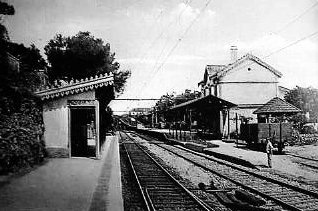
Right: Paço de Arcos station c.1940
The line now runs inland with the river no longer visible. Paço de Arcos is named after the Palace of Arches whose origins are late fifteenth century. In the late 19th century the town had a popular beach.
In summer 2003 the area to the right of the station was redeveloped and the SATUO monorail installed to link the town to Oeiras (Parque). This had a blue-tiled terminal station, called "Navegantes", within yards of the Cascais end of the Lisbon-bound platform. It is now defunct though its curving track is still visible (2019).
As the Cascais Line leaves the station, it crosses a small viaduct and the line runs past blocks of flats and the bustling fire station below. A modern sculpture, possibly a stylised Barcelos cockerel (a folkloric symbol), has been erected near some new flats on the right between here and Santo Amaro. After a brief break in the housing on the right, the train now reaches
 SANTO AMARO (DE OEIRAS) (15.5km). This stop should not be confused with Santo Amaro, the area beneath the Ponte 25 de Abril, near
Alcântara.
SANTO AMARO (DE OEIRAS) (15.5km). This stop should not be confused with Santo Amaro, the area beneath the Ponte 25 de Abril, near
Alcântara.
The Cascais lines then cross an 87m steel viaduct over a small river
(Rio Lage) before entering the station.
On the right-hand side, deep below the elevated railway line, used to reside an incongruously sited yellow Lisbon bogie tram, placed there as a park exhibit for children.

 OEIRAS (16.2km)
Rush-hour morning and evening services from Cais do Sodré terminate here, alternating with the through service to Cascais. The large buildings on the left are the former Oeiras Foundry, with its railway inspired ceramic mural, and the Estoril line railway shed and works.
OEIRAS (16.2km)
Rush-hour morning and evening services from Cais do Sodré terminate here, alternating with the through service to Cascais. The large buildings on the left are the former Oeiras Foundry, with its railway inspired ceramic mural, and the Estoril line railway shed and works.
Virtually all of the Line's stock was once stabled here, having previously been at Cais do Sodré and, later, at Carcavelos. The Line's refurbished, air-conditioned rolling stock made its first test appearance here in 1998 but was not introduced into service and, even then, only on a small scale, till 17 July, 1999.
The through trains to/from Cascais use the outer sides of the two platforms, whilst the terminating services use the middle track. Oeiras Town Council has a web-site detailing the town's attractions, which include the home of the 18th-century Marquis of Pombal, who rebuilt Lisbon after the 1755 earthquake. This lies about 10 minutes walk away, to the north of the station.

 CARCAVELOS (17.8km) On the approach to the station, at a raised level on the left, are the current sidings of the Cascais Line railway opened c.2000. To the left is the road to the beach, about five minutes away.
CARCAVELOS (17.8km) On the approach to the station, at a raised level on the left, are the current sidings of the Cascais Line railway opened c.2000. To the left is the road to the beach, about five minutes away.
At Carcavelos was sited a transatlantic communications cable, opened in 1872. This had 3 cables to Falmouth, 2 to Gibraltar, 2 to Brazil and 1 to the Azores.
To the right of the rebuilt station are shops, a cinema and cafés. To the left is a bus interchange, which opened in Spring, 2000, replacing the bus terminus on the other side of the station. Further information on the town is on the Carcavelos local council's web-page.
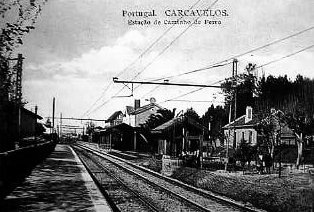
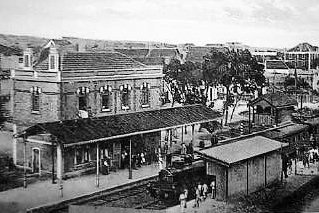
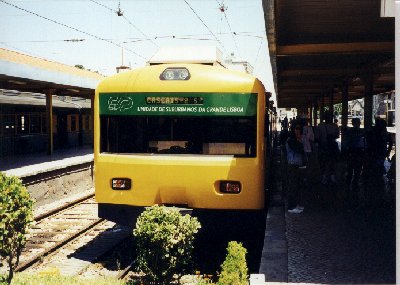
L to R: Period postcard views of Carcavelos and Parede stations; a refurbished unit at Cais do Sodré, July, 2000.

 PAREDE (19.5km) Parede was developed in the nineteenth century, on agricultural land, by Almirante José Nunes da Mata, (admiral and writer, 1849-1945) and the town has a park named after him.
PAREDE (19.5km) Parede was developed in the nineteenth century, on agricultural land, by Almirante José Nunes da Mata, (admiral and writer, 1849-1945) and the town has a park named after him.
In 1904 a large sanatorium (Sanatório de Sant'Anna) was opened here by the wife of the capitalist Frederico Biester. Like Carcavelos, the station has been rebuilt in recent years. The British Council has premises beside the line on the left beyond the station.
Although the property here is generally up-market, there was a small shanty-settlement on the right as the train nears S. Pedro but in summer 2004 this was replaced by a low-cost apartment block. On the left was the historic Colónia Balnear Infantil 'O Século', a large building established to provided seaside facilities for children. There is a modest beach a short walk from the station.

 SÃO PEDRO (DO ESTORIL) (21km) Apartment blocks herald arrival at S. Pedro. Some services used to terminate here at peak timesand, as at Oeiras, transfer to through stations was achieved by simply walking across the platform (1P1P1).
SÃO PEDRO (DO ESTORIL) (21km) Apartment blocks herald arrival at S. Pedro. Some services used to terminate here at peak timesand, as at Oeiras, transfer to through stations was achieved by simply walking across the platform (1P1P1).
Formerly, during the day, two units were often stabled on the centre track but, in summer 2010, the whole station was remodelled.
The sea can be seen across the Marginal road, on the left-hand side of the track. The town was known as Cae Água until well into the twentieth century and it has a reasonable beach. The town's development owes much to the retail magnate, Nunes dos Santos, who founded the Grandes Armazéns do Chiado, a fashionable department store in Lisbon.
Leaving the station, a small bus station can be seen for Scott URB Portugal services (to the right).

 SÃO JOÃO (DO ESTORIL) (22.5km) Like many of the stations, S. João has adjacent cafes and bars, including for many years the interestingly named 'Tony Sandwich Bar'.
SÃO JOÃO (DO ESTORIL) (22.5km) Like many of the stations, S. João has adjacent cafes and bars, including for many years the interestingly named 'Tony Sandwich Bar'.
There are two beaches here; the Praia da Poça and the Praia de Azarujinha. After passing through a cutting, the train rejoins the coast at Estoril.
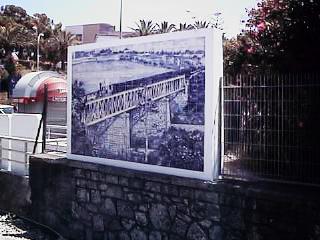
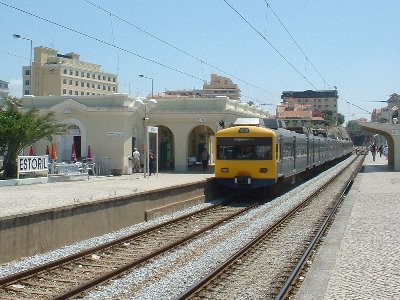
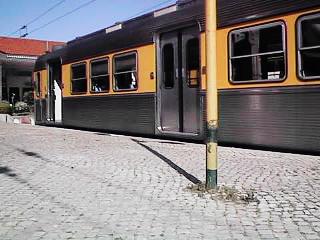
L to R: A ceramic representation of a steam train crossing the Oeiras viaduct is to be found at the eastern end of Oeiras station; a train bound for Lisbon departs Estoril station (July 2003); an EMU waits at Cascais
station, (April 24, 1999)..

 ESTORIL (23.6km)
Though you would not suspect it, formerly the stylish Sud-Expres from Paris served this station in a town once-famous as
ESTORIL (23.6km)
Though you would not suspect it, formerly the stylish Sud-Expres from Paris served this station in a town once-famous as
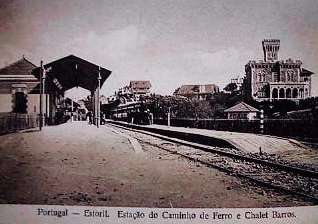 the home of deposed European royalty.
the home of deposed European royalty.
The beach lies to the left of the station; the ScottURB (ex-Stagecoach) bus terminal and kiosk is immediately to the right. Beyond it lies the famous Casino which is reached past a semi-circular arcade on the left which houses several good-value open-air restaurants amongst which the best is probably the Yate (Yacht). Its open-air tables also provide a good point for observing local bus services, which also stop outside the station itself. For further information,
see the Sintra Transport page and the Lisbon Suburban Buses page.

 MONTE ESTORIL (24.3km) A number of hotels lie near the station, including the Grande, and the Aparthotel Eden. However, the Atlântico (immediately next to the railway line on the right) underwent under major renovation c.2007 and is now an apartment block.
MONTE ESTORIL (24.3km) A number of hotels lie near the station, including the Grande, and the Aparthotel Eden. However, the Atlântico (immediately next to the railway line on the right) underwent under major renovation c.2007 and is now an apartment block.
Monte Estoril became an international health resort at the turn of the nineteenth-century and even the Queen of Portugal (D. Maria Pia) had a 'chalet' here. In the early twentieth century the beach here was still sandy but is now rocky.
The line runs along the Atlantic coastline between the former Atlântico hotel and the Ocean, before passing the former site of the massive Estoril-Sol hotel (demolished in summer 2007) on the land side and the excellent Jumbo hypermarket, as it enters the terminal at Cascais. An office block replaced the Estoril-Sol complex.

 CASCAIS (25.4km) The line terminates on the edge of this still-active fishing port, although tourism now dominates the economy. A short walk (c. 5 minutes) ahead from the station takes you to the beach and historic town hall, near the Baia Hotel.
CASCAIS (25.4km) The line terminates on the edge of this still-active fishing port, although tourism now dominates the economy. A short walk (c. 5 minutes) ahead from the station takes you to the beach and historic town hall, near the Baia Hotel.
The bus station has recently been installed under the new Vila shopping complex, across the road (to the right) from the station. The shopping complex has fine view from its top floor café/balcony. The main bus operator is ScottURB.
Just a few yards further back towards Lisbon is the excellent Jumbo hypermarket. On the other (west) side of the small town is the excellent Castro Guimarães museum, a stately home.
Cascais also has many restaurants, hotels and a bullring. Nearby is the out-of-town Cascaishopping centre and a motor-racing track, both of which lie on local bus routes.
The town's charter goes back to 1364 and in 1964 it gained the status of a cidade. Local fishing boats operate from the Praia da Rainha, whilst the Duquesa, Rainha and Conceição beaches are less disturbed for sunbathers. For further information on the town, Cascais town council operates a web-site in Portuguese.
Tickets
Automated ticketing is available at all stations. The tickets are the Viva Viagem style but bear the prefix CP (for Caminhos de Ferro Portugueses) rather than the ML prefix found on Lisboa metro and Carris tickets. There is no discount on return tickets. Ticket inspectors still check passengers' tickets on the trains.
Rolling Stock
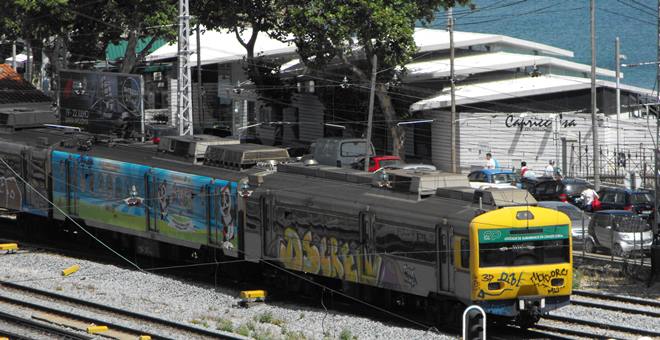
Sadly, much of the rolling stock and virtually all of the stations on the Cascais Line are defaced by graffiti. Also a number of carriages bear all-over advertising. Above is shown a defaced train entering Cascais station, 2012, with the second carriage carrying all-over advertising.
Extensively reconditioned rolling stock was introduced from July 1998. This comprised 34 revamped units by the year 2002. These are made up of 21 four-car sets and 13 three-car sets.
These vehicles have smoked windows, interior stop indicators, air-conditioning and soundproofing. Only the bogies and the body-sides remain from the original vehicles. The new front ends and ungainly roof-mounted air-conditioning units do not enhance the appearance of the trains, but for the passenger the above-mentioned benefits, together with the smoother ride resulting from 'chopper' control, do constitute significant advances.
The cost of this modernisation was ten billion escudos.
Copyright: ©
Contact: the following is not a link; please transcribe the address into your email 

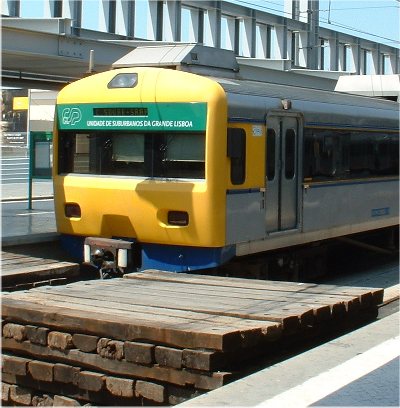
 June 2019
June 2019






 CAIS DO SODRÉ (0km) The station, has a walkway link to the
CAIS DO SODRÉ (0km) The station, has a walkway link to the  SANTOS (0.9km) The former dockland area to the left of the line has now largely been reborn as a strip of discotheques and fashionable nightclubs, restaurants and bars.
SANTOS (0.9km) The former dockland area to the left of the line has now largely been reborn as a strip of discotheques and fashionable nightclubs, restaurants and bars.


 ALCÂNTARA-MAR (2.6km) An elevated walk-way connects this station to the CP terminal station of Alcântara-Terra. To the left are part of the city's extensive passenger and cargo docks. Nearby, to the right, is the Necessidades Palace and the Carris tram sheds, museum and offices at Santo Amaro, (not to be confused with Santo Amaro [de Oeiras], a stop further along this railway line).
ALCÂNTARA-MAR (2.6km) An elevated walk-way connects this station to the CP terminal station of Alcântara-Terra. To the left are part of the city's extensive passenger and cargo docks. Nearby, to the right, is the Necessidades Palace and the Carris tram sheds, museum and offices at Santo Amaro, (not to be confused with Santo Amaro [de Oeiras], a stop further along this railway line).



 BELÉM (4.8km) Alight here for the Museu de Electricidade (Electricity Museum), housed in the former power station (1919) to the left, and the new MAAT museum.
BELÉM (4.8km) Alight here for the Museu de Electricidade (Electricity Museum), housed in the former power station (1919) to the left, and the new MAAT museum.
 ALGÉS (7.8km) There is a major
ALGÉS (7.8km) There is a major  CRUZ QUEBRADA (9.7km). This was formerly the western terminus of Carris tram service 15. An unprepossessing beach can be seen on the left. The line here runs right along the river edge and curves around a lighthouse, sited inland from the railway, before a gentle gradient brings the train to
CRUZ QUEBRADA (9.7km). This was formerly the western terminus of Carris tram service 15. An unprepossessing beach can be seen on the left. The line here runs right along the river edge and curves around a lighthouse, sited inland from the railway, before a gentle gradient brings the train to
 CAXIAS (11.7km). As the train enters the station, an old railway carriage, now a bar, is to be seen on the right. The small
beach is near to the refurbished Forte S. Bruno, which was originally built c.1660 by the Conde de Cantanhede (1596-1675) after the 1640 Restoration of Portugal's independence from Spain.
CAXIAS (11.7km). As the train enters the station, an old railway carriage, now a bar, is to be seen on the right. The small
beach is near to the refurbished Forte S. Bruno, which was originally built c.1660 by the Conde de Cantanhede (1596-1675) after the 1640 Restoration of Portugal's independence from Spain.
 PAÇO DE ARCOS (13.2km)
PAÇO DE ARCOS (13.2km)

 SANTO AMARO (DE OEIRAS) (15.5km). This stop should not be confused with Santo Amaro, the area beneath the Ponte 25 de Abril, near
Alcântara.
SANTO AMARO (DE OEIRAS) (15.5km). This stop should not be confused with Santo Amaro, the area beneath the Ponte 25 de Abril, near
Alcântara.
 OEIRAS (16.2km)
Rush-hour morning and evening services from Cais do Sodré terminate here, alternating with the through service to Cascais. The large buildings on the left are the former Oeiras Foundry, with its railway inspired ceramic mural, and the Estoril line railway shed and works.
OEIRAS (16.2km)
Rush-hour morning and evening services from Cais do Sodré terminate here, alternating with the through service to Cascais. The large buildings on the left are the former Oeiras Foundry, with its railway inspired ceramic mural, and the Estoril line railway shed and works.








